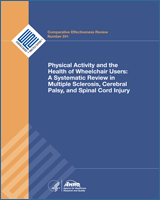| Etiology | Traumatic injury to a developing brain before, during, or after birth | Progressive autoimmune disease of the central nervous system with variable disease patterns; 10% primary progressive and others progressive after initial relapse and remitting course | Usually traumatic cord injury (motor vehicle accidents, falls, violence, sports); nervous system above the lesion is intact |
| Prevalence | 1.5 to more than 4 per 1,000 live births; males 30% greater than females; 764,000 children and adults living with CP in the United States6 | Nearly 1 million people in the United States have MS; average age onset 30 years old and females 2 to 3 times males7 | Estimated 282,000 in the United States with SCI; recent evidence puts the average age 43 years old; 78% male8,9 |
| Mobility | 40% limitations in walking and 30% use walkers or wheelchairs | Mobility limitations generally occur later in disease course; after 45 years of disease, on average 76% of individuals require ambulatory aid and 52% bilateral assistance10 | Variable and depends on level and completeness of injury; generally stable after injury and initial rehabilitation |
| Associated morbidity | 40% of children with CP have intellectual disability, 35% epilepsy, and more than 15% had vision impairment | Sequela of immune suppression including urinary and respiratory infections, seizures, other autoimmune diseases, visual abnormalities, ataxia11 | Respiratory complications, thromboembolism, autonomic dysreflexia, orthostatic hypotension, bladder dysfunction, neurogenic bowel, spasticity, pain, pressure ulcers12 |
| Usual intent of physical activity | Increase mobility and overall level of function as component multimodality efforts during childhood development | Maintain mobility and attenuate limitations of progressive disease; because those with MS often have normal life expectancies the benefits of exercise for the general population would also apply | Maximize functional abilities; recreation; because long-term sequela SCI better prevented/managed, longer term health benefits of regular exercise also are relevant |
